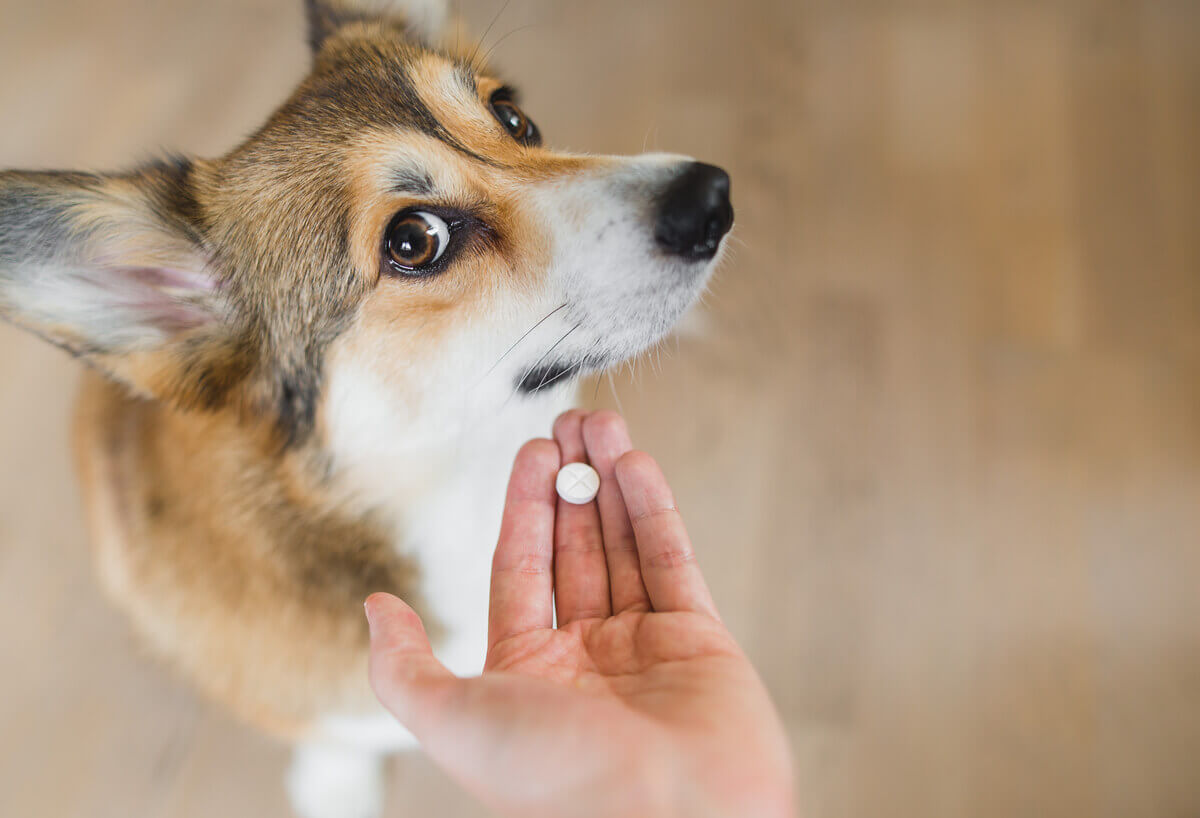What Are the Uses of Clindamycin in Dogs?

Veterinary drugs for dogs, especially prescription drugs, such as antibiotics including clindamycin, can’t be prescribed lightly. If you think your dog needs a drug or you suspect that it’s suffering from an ailment, you should always take it to the vet to confirm a diagnosis and then start the appropriate treatment. In this article, we’ll show you the uses of clindamycin in dogs.
If you don’t agree with the procedure the professional chooses or don’t see your pet getting any better, then you always have the option of getting a second opinion from another veterinarian. Nevertheless, don’t consider it a substitute for veterinary consultation.
Types of veterinary drugs
Before we get into clindamycin, we’re going to talk about veterinary drugs in general. In the field of veterinary medicine, drugs are classified depending on their therapeutic use or from a legal standpoint.
The first classification is broader, since it refers to the drug’s function and mechanism of action. These are the types of veterinary drugs that exist:
- Antibiotics. Vets prescribe them for the treatment of any bacterial infectious disease. Within this group, we also find different types of classifications according to their spectrum of activity and function. For example, clindamycin acts on several Staphylococcus and Streptococcus species.
- Antifungal drugs. They treat fungal infections. The most commonly used are itraconazole and fluconazole.
- Antiparasitics for internal and external parasites. The drug owners usually buy them in vet clinics to deworm their pets.
- Anti-inflammatory drugs. These are symptomatic drugs, meaning they don’t cure the underlying cause. They reduce swelling caused by trauma, illness, or surgery.
- Antiseptics and disinfectants. These are for topical use, to control or prevent skin infections.
- Cardiovascular, renal, respiratory, or neurological drugs.
- Reproductive system drugs.
- Intravenous fluid therapy. Drugs that are administered intravenously to hospitalized animals.
- Biological drugs. This group includes vaccines, specific to each species, such as those for rabies, kennel cough, or leishmaniasis, among others.

Specific action drugs are usually those prescribed for the treatment of specific diseases, such as hypertension, kidney disease, and digestive problems, to relieve pain and other discomforts.
The second classification we mentioned above takes the legal aspects of each drug into account. These two categories include all the previous types:
- Veterinary prescription drugs by registered veterinarians, such as antibiotics or certain specific action drugs. Some have special prescriptions, such as narcotic drugs.
- Over-the-counter (OTC) drugs.
The uses of clindamycin in dogs
Clindamycin is an antibiotic, meaning it fights bacterial infections. Antibiotics don’t only kill these pathogens directly but can also affect their vital functions, ultimately preventing them from spreading.
Specifically, clindamycin belongs to the class of lincosamides, which are antibiotics that inhibit the synthesis of bacterial proteins. This drug works mainly on anaerobic organisms, such as some species of Staphylococcus, Streptococcus, Bacteroides, Clostridium, and Fusobacterium genera.
Protein synthesis inhibition is possible thanks to the structural differences between the ribosomes of eukaryotes, multicellular beings, and prokaryotes, unicellular beings, such as bacteria and protozoa.
Clindamycin detects the components of bacterial ribosomes. Thus, the drug paralyzes bacterial production in the body. This medicine is a bacteriostatic agent. However, it can also be bactericidal, depending on its concentration and the microorganism it works against.
Other antibiotics that have a similar mechanism of action to clindamycin are chloramphenicol, lincomycin, and doxycycline, among others.
The main uses of clindamycin in dogs
This antibiotic is used in both dogs and cats. It’s contraindicated in other animals such as rabbits, guinea pigs, hamsters, chinchillas, horses, or ruminants. This is because it could cause gastrointestinal disorders.
These are the typical uses for clindamycin in dogs:
- For the treatment of infected oral cavity wounds, abscesses, and infections caused by, or related to, clindamycin-sensitive species of the genera Staphylococcus, Streptococcus, Bacteroides, or by Clostridium perfringens and Fusobacterium necrophorum.
- Complementary medicine for the treatment of gum or periodontal infections.
- To treat osteomyelitis caused by Staphylococcus aureus.
You should administer the dose the veterinarian indicated, for as long as they see fit. Following this to the letter is very important when it comes to antibiotics, as it avoids relapses and antibiotic resistance. Also, it’s essential not to combine clindamycin with other veterinary drugs, such as chloramphenicol.
In addition, you must be really careful when administering these drugs to dogs with kidney and/or liver problems. In these cases, your dog may need to get tested to see their liver and kidney respond to the treatment.

Finally, we should note that clindamycin is administered only orally and the expiration date is specified on the box. Don’t give your dog any expired drug.
Veterinary drugs for dogs, especially prescription drugs, such as antibiotics including clindamycin, can’t be prescribed lightly. If you think your dog needs a drug or you suspect that it’s suffering from an ailment, you should always take it to the vet to confirm a diagnosis and then start the appropriate treatment. In this article, we’ll show you the uses of clindamycin in dogs.
If you don’t agree with the procedure the professional chooses or don’t see your pet getting any better, then you always have the option of getting a second opinion from another veterinarian. Nevertheless, don’t consider it a substitute for veterinary consultation.
Types of veterinary drugs
Before we get into clindamycin, we’re going to talk about veterinary drugs in general. In the field of veterinary medicine, drugs are classified depending on their therapeutic use or from a legal standpoint.
The first classification is broader, since it refers to the drug’s function and mechanism of action. These are the types of veterinary drugs that exist:
- Antibiotics. Vets prescribe them for the treatment of any bacterial infectious disease. Within this group, we also find different types of classifications according to their spectrum of activity and function. For example, clindamycin acts on several Staphylococcus and Streptococcus species.
- Antifungal drugs. They treat fungal infections. The most commonly used are itraconazole and fluconazole.
- Antiparasitics for internal and external parasites. The drug owners usually buy them in vet clinics to deworm their pets.
- Anti-inflammatory drugs. These are symptomatic drugs, meaning they don’t cure the underlying cause. They reduce swelling caused by trauma, illness, or surgery.
- Antiseptics and disinfectants. These are for topical use, to control or prevent skin infections.
- Cardiovascular, renal, respiratory, or neurological drugs.
- Reproductive system drugs.
- Intravenous fluid therapy. Drugs that are administered intravenously to hospitalized animals.
- Biological drugs. This group includes vaccines, specific to each species, such as those for rabies, kennel cough, or leishmaniasis, among others.

Specific action drugs are usually those prescribed for the treatment of specific diseases, such as hypertension, kidney disease, and digestive problems, to relieve pain and other discomforts.
The second classification we mentioned above takes the legal aspects of each drug into account. These two categories include all the previous types:
- Veterinary prescription drugs by registered veterinarians, such as antibiotics or certain specific action drugs. Some have special prescriptions, such as narcotic drugs.
- Over-the-counter (OTC) drugs.
The uses of clindamycin in dogs
Clindamycin is an antibiotic, meaning it fights bacterial infections. Antibiotics don’t only kill these pathogens directly but can also affect their vital functions, ultimately preventing them from spreading.
Specifically, clindamycin belongs to the class of lincosamides, which are antibiotics that inhibit the synthesis of bacterial proteins. This drug works mainly on anaerobic organisms, such as some species of Staphylococcus, Streptococcus, Bacteroides, Clostridium, and Fusobacterium genera.
Protein synthesis inhibition is possible thanks to the structural differences between the ribosomes of eukaryotes, multicellular beings, and prokaryotes, unicellular beings, such as bacteria and protozoa.
Clindamycin detects the components of bacterial ribosomes. Thus, the drug paralyzes bacterial production in the body. This medicine is a bacteriostatic agent. However, it can also be bactericidal, depending on its concentration and the microorganism it works against.
Other antibiotics that have a similar mechanism of action to clindamycin are chloramphenicol, lincomycin, and doxycycline, among others.
The main uses of clindamycin in dogs
This antibiotic is used in both dogs and cats. It’s contraindicated in other animals such as rabbits, guinea pigs, hamsters, chinchillas, horses, or ruminants. This is because it could cause gastrointestinal disorders.
These are the typical uses for clindamycin in dogs:
- For the treatment of infected oral cavity wounds, abscesses, and infections caused by, or related to, clindamycin-sensitive species of the genera Staphylococcus, Streptococcus, Bacteroides, or by Clostridium perfringens and Fusobacterium necrophorum.
- Complementary medicine for the treatment of gum or periodontal infections.
- To treat osteomyelitis caused by Staphylococcus aureus.
You should administer the dose the veterinarian indicated, for as long as they see fit. Following this to the letter is very important when it comes to antibiotics, as it avoids relapses and antibiotic resistance. Also, it’s essential not to combine clindamycin with other veterinary drugs, such as chloramphenicol.
In addition, you must be really careful when administering these drugs to dogs with kidney and/or liver problems. In these cases, your dog may need to get tested to see their liver and kidney respond to the treatment.

Finally, we should note that clindamycin is administered only orally and the expiration date is specified on the box. Don’t give your dog any expired drug.
All cited sources were thoroughly reviewed by our team to ensure their quality, reliability, currency, and validity. The bibliography of this article was considered reliable and of academic or scientific accuracy.
- Agencia española de medicamentos y productos sanitarios.
- Enfermedades Infecciosas y Microbiología Clínica. Elsevier. Mecanismos de acción de los antimicrobianos .Vol. 27. Núm. 1. páginas 44-52 (Enero 2009).
- MERCK & CO., INC. El manual Merk de veterinaria. Barcelona, Océano Grupo Editorial, 2000.
- PLUMB .Manual de Farmacología Veterinaria. Buenos Aires, Intermédica, 2006.
This text is provided for informational purposes only and does not replace consultation with a professional. If in doubt, consult your specialist.








